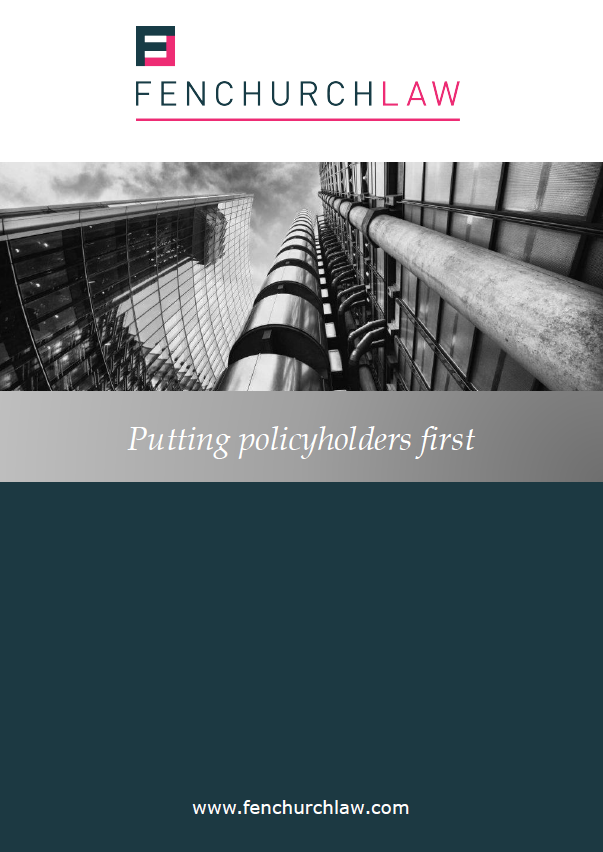
The underinsurance crisis: legal repercussions, broker responsibilities, and growing solutions
Underinsurance is still a major, pressing issue in the UK insurance market, with recent figures revealing that a huge 76% of commercial buildings are currently underinsured. While this is an improvement from 81% in 2023 and 83% at its peak, the statistics reveal a systemic issue which affects businesses, policyholders, and every facet of the insurance ecosystem.
In a recent webinar on Underinsurance and the Insurance Act 2015, Alex Rosenfield, Partner at Fenchurch Law, delved into the world of underinsurance, why it’s become such a huge problem for our industry, the remedies that insurers may apply under the Insurance Act 2015, the legal and financial consequences for policyholders and brokers, and finally, some suggested strategies to mitigate the risks of underinsurance.
What is underinsurance?
Taking it back to basics, underinsurance arises when the total sum insured cannot cover the full cost of rebuilding or repairing a property. The gap between the true value, and the insured value can be created for many reasons.
- Failure to factor in full rebuild costs: Including demolition, debris removal, professional fees (e.g. architects and builders).
- Inflation: Rising costs of labour, materials, and equipment may not be reflected in outdated valuations.
- Forgetting VAT: This can be especially problematic for businesses that cannot reclaim VAT.
- Intentional underinsurance: The deliberate choice to disclose lower values to reduce premiums, a risky choice which can have detrimental implications on the policy holder.
Even financially educated clients and policyholders can end up underinsured, and one of the biggest reasons is a lack of diligence.
The implications of being underinsured can be very serious. Insurers tend to apply an average clause, and the policyholder may find themselves in financial crisis, needing to fund the difference between the sums insured, and the true asset value.
Alex stressed, “Underinsurance can be disastrous with large claims, but even partial losses can still leave policyholders under-compensated.”
As an alternative (and potentially in addition) to applying average, the insurer can apply a remedy for a breach of the duty of fair presentation under the Insurance Act 2015 (“the IA 2015”), which will depend on whether the breach was deliberate or reckless, or merely carless. If it was deliberate or reckless, the insurer can refuse to pay the claim, or void the policy altogether.
If this happens, the policyholder would most likely have to share this information with a future insurer, and they may be marked as a ‘moral hazard’, reducing their perceived capacity to suffer a loss of a particular kind.
It could also frustrate business continuity in some cases, as the insured may need to wait for financial stability, and in another commercial sense, beyond the financial hit, the act of underinsuring may put directors in breach of their statutory duties.
Insurer remedies for underinsurance
Alex explained that insurers most commonly utilise one of two remedies:
The Average Clause is the most common contractual remedy, proportionally reducing the claim to discourage underinsurance and reinforce the importance of accurate valuations.
There is also the possibility of the insurer applying a remedy for a breach of the duty of presentation under the IA 2015. If the breach was deliberate or reckless, the insurer can avoid the policy and refuse all claims, and keep the premium. If it was careless or negligent, the insurer’s remedy will be proportionate, and turn on what the underwriter would have done differently had the true insured sums been disclosed.
Can insurers apply both remedies?
Alex addressed a nuanced and (currently) legally untested question: Can an insurer apply both average and a proportionate remedy under the Insurance Act to the same failure?
While technically possible, Alex argued this would likely be seen as commercially unfair and commercially unattractive, creating a double punishment. A more reasonable response, he argues, is a single repercussion based on the circumstances and severity of the breach.
“To my mind, applying both remedies cumulatively doesn’t sound very attractive, because policyholders effectively be punished twice for the same failure. I think a better analysis, which I think sounds a lot more commercial, is that the insurer picks one or the other, which may just depend on how this has all happened.”
Declaration-linked and waiver of average cover
Declaration-Linked Cover (a premium based on estimated gross profit), avoids average application, unless dishonesty is involved, and is especially useful for those businesses with changeable values and success. Traditional Sum Insured with Waiver of Average promises full claim payouts without average deductions, which is also ideal for businesses that struggle with accurate valuations. However, with a waiver of average, not disclosing ‘material’ changes, such as business value growth, may still be considered a breach of the duty of fair presentation.
“Average and the remedies that insurers have under the Insurance Act can be targeted for very different things. Where an average deals with inactive, inadequate cover that the insured chooses, which is a contractual term, the values of the Insurance Act address inadequate disclosure, which affect the risk so they do address different things.”
Having covered the insurer’s and policyholder’s responsibilities at length, where does the broker stand, what are their responsibilities?
The broker’s role
Alex went on to highlight the role of the broker in helping clients to mitigate the risk of underinsurance. The Infinity Reliance v Heath Crawford case serves as a significant warning to brokers about the importance of comprehensive client advice and clear communication about insurance terms.
Infinity Reliance, an online retailer, experienced a devastating warehouse fire, but after realising that the business was underinsured, the covered value was only 26% of the actual rebuild cost (which was around £33m). The insurer, Aviva, decided to apply average, leaving the business £3 million out of pocket.
But how was the broker implicated? Infinity alliance sued their broker, Heath Crawford, claiming that he had shared misleading documentation, failed to provide proper advice on the insurance calculation, and that he had not considered the alternative premises and additional costs in his advice.
The court agreed with the policyholder, finding the broker had breached his duty. How?
- Not explaining the potential downsides of the chosen insurance type
- Failing to clarify the implications of average and coverage limits
- Not ensuring that the client’s insurance choice was informed and genuine.
Indeed, while Infinity Reliance expressed that they didn’t want to suffer a premium change, the broker was ultimately in breach of duty, as a reasonable broker would recommend a declaration of cover.
“The broker must ensure the client understands any disadvantageous consequences, such as the risk that underinsurance would lead to any claim being reduced by average… even when a preference isn’t expressed, the reasonable broker should check that it remains a genuine and informed choice,” Alex clarified.
Today’s legal landscape and practical solutions
While the Insurance Act 2015 introduced clearer frameworks, case law is still limited, leaving policyholders and insurers uncertain, especially on the potential for “double dipping” and the full implications of negligent misrepresentations.
So, what does Alex suggest to help combat the major issue?
- Address the root cause: diligence
There are many reasons for underinsurance, but there is one key theme amongst all reasons: a lack of diligence. It is of the highest importance to express the need for regular evaluations make sure that the policy covers all the necessary rebuild elements, and also to take account of inflation. It is also imperative that the policy holder reviews these figures annually.
“Never assume that the figures and costs that were adequate yesterday will be relevant today.”
- Clarify remedy application
Insurers can, theoretically, apply cumulative remedies to the same ‘failure’, even if it feels “very draconian”. A practical solution is to actually discuss the remedy that might apply with insurers, and in what circumstances. That therefore creates certainty for all parties involved.
- Educate clients thoroughly
Brokers must explain the consequences to the policyholder of not insuring adequately; “It does go about saying that policyholders do need to be aware that other insurance can lead to serious shortfalls, even for partial losses.”
“Concepts such as average or declaration linked cover won’t be obvious to everybody, so it is important to make sure that your policyholder clients know precisely what those terms mean.”
Underinsurance is not just a hidden gap in coverage, but a systemic vulnerability that has the capacity to shake business stability. With 76% of buildings underinsured, this is a problem that demands urgent attention from the entire insurance ecosystem: from insurers to policyholders to brokers.
The combined force of regulatory obligations, court decisions like Infinity Alliance, makes it clear: accurate valuation, diligent disclosure, and client education are necessities to combating this widespread issue in the current risk market.
Alex Rosenfield is a Partner at Fenchurch Law
Other news
When can an insurer join the party? Managed Legal Solutions v Mr Darren Hanison (trading as Fortitude Law) and HDI Global Specialty SE [2025]
6 January 2026
This recent High Court judgment sheds light on the circumstances under which an insurer may be joined as a party to…
You may also be interested in:
Archives
Categories
- Operations
- Business Development
- Construction & Property Risks
- News
- International Risks
- Legislation
- Financial & Professional Risks
- Case Law
- Professional Risks
- Press Release
- Uncategorized
- The Good, the Bad and the Ugly
- Fenchurch Law Webinars
- Stonegate
- Newsletter
- Events
- Webinars
- Comparing German and English Insurance Law – A Series
- Construction Risks



